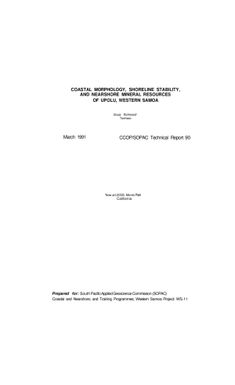Coastal morphology, shoreline stability, and nearshore mineral resources of Upolu, Western Samoa
- Description:
- A coastal mapping programme was initiated on Upolu Island in Western Samoa as a means of providing a framework within which to identify broad geologic patterns (Roy and Richmond, 1986). The first stage of this programme involved the interpretation of aerial photographs of coastal deposits followed by field verification. Mapping of large areas provides a mechanism whereby the results of more detailed studies can be better applied to the understanding of the entire coastline. The shoreline, reef flats, and coastal plain of Upolu were investigated by a reconnaissance survey designed to examine near shore mineral resources (primarily construction materials), potential geo-hazards, and coastal processes. This report is designed to accompany ten 1:20,000 scale maps (4 sheets) produced of the Upolu coastal zone. Appendix-I provides brief summary descriptions of the reef types, coastal plains, shoreline stability, and resources for each sheet.
- Display date:
- 1991
- Collections:
- Secretariat of the Pacific Regional Environment Programme (SPREP)
- Publisher:
- Applied Geoscience and Technology Division (SOPAC) of SPC
- Content partner:
- Secretariat of the Pacific Regional Environment Programme (SPREP)
- Availability:
- Not specified
-
Copyright status: All rights reservedFind out more about what you are able to do with this itemThis item is all rights reserved, with means you'll have to get permission from Secretariat of the Pacific Regional Environment Programme (SPREP) before using it. For more information, please see our use and reuse page.What can I do with this item?Non-infringing useNZ copyright law does not prevent every use of a copyright work, and this item may be hosted by an international institute or organisation. You should consider what you can and cannot do with a copyright work.No sharingYou may not copy and/or share this item with others without further permission. This includes posting it on your blog, using it in a presentation, or any other public use.No modifyingYou are not allowed to adapt or remix this item into any other works.No commercial useYou may not use this item commercially.
Related items
Welcome and warm Pasifik greetings
The information on this site has been gathered from our content partners.
The names, terms, and labels that we present on the site may contain images or voices of deceased persons and may also reflect the bias, norms, and perspective of the period of time in which they were created. We accept that these may not be appropriate today.
If you have any concerns or questions about an item, please contact us.
